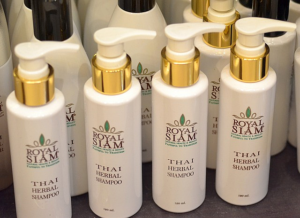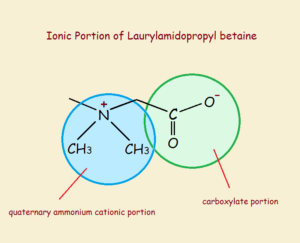 Shampoos are hair-care products meant to clean hair while allowing it to remain manageable. Is shampoo soap, detergent, or what? Individual shampoo products may contain many different ingredients to impart additional characteristics, but largely mainstream shampoos consist of two combined surfactants. Sodium laureth sulfate or sodium lauryl sulfate is the main surfactant. Cocamidopropyl betaine is the secondary surfactant. We will consider these two ingredients in answering the title question.
Shampoos are hair-care products meant to clean hair while allowing it to remain manageable. Is shampoo soap, detergent, or what? Individual shampoo products may contain many different ingredients to impart additional characteristics, but largely mainstream shampoos consist of two combined surfactants. Sodium laureth sulfate or sodium lauryl sulfate is the main surfactant. Cocamidopropyl betaine is the secondary surfactant. We will consider these two ingredients in answering the title question.
Sodium Lauryl Sulfate
Sodium lauryl sulfate (also called sodium dodecyl sulfate) is an anionic surfactant. One online definition of a surfactant reads: “a substance that tends to reduce the surface tension of a liquid in which it is dissolved”. For the purposes of our discussion, we identify sodium lauryl sulfate as a detergent, rather than a soap. Detergents do not fail to function in hard water as a soap does.
But what does it mean when it says SLS is anionic? An ion is an atom or molecule that is not electrically neutral. In water, sodium lauryl sulfate forms a positive ion (or cation) and a negative ion (or anion). We write,
H3C-(CH2)11-OSO3-Na → H3C-(CH2)11-OSO3– + Na+
Sodium is the cation. The remainder of the molecule is the anion. It is the long chain anionic portion that gives this substance its anionic surfactant identification. This portion of the molecule is called the organosulfate portion.
Sodium Laureth Sulfate
Sodium laureth sulfate, with its similar sounding name, is also known as sodium lauryl ether sulfate (SLES). It, too, is an anionic surfactant. In water, its transformation is written,
H3C-(CH2)11-(OCH2CH2)n-OSO3-Na → H3C-(CH2)11-(O CH2CH2)n-OSO3– + Na+
What is the difference, other than a purely chemical one, between sodium lauryl sulfate and sodium laureth sulfate?
So What’s the Difference?
It requires an additional step to convert SLS to SLES. Additional steps cost additional money. So why do some choose SLES for their shampoo? What is the difference? To quote the reference cited below, “SLS is a skin irritant. This can cause some minor skin irritations like dry, itchy skin. SLES is formulated [to] be much milder and not irritate the skin.” Both SLS and SLES are added, in part, because of their foaming characteristic. Foam is equated with a successful cleaner by the average consumer.
Cocamidopropyl Betaine

Cocamidopropyl betaine is actually a mixture of compounds derived from coconut oil. Chemically, its major component, lauramidopropyl betaine, is written,
H3C-(CH2)10-(CO)(NH)-(CH2)3-(N+(CH3)2)-CH2-COO–
Notice both the positive and negative charges are part of the same molecule, even without the presence of water. Such a molecule is called a zwitterion. As such, it is not classed as purely ionic. Cocamidopropyl betaine is added to shampoos to promote foaming and to reduce irritation.
Note: You might also enjoy What is the Difference Between Soap and Detergent?
References:

I know some people who will not buy shampoos with sodium lauryl sulphate in them. Now I know why! Thanks.
Very interesting article. I’ve always wondered why they have so many different types of shampoos for dry, oily, fly-away, natural….hair, yet they all seem to have basically the same ingredients.
Shampoo was once recommended in a Hints from Heloise article. It said shampoo was a better cleanser for bathtubs than cleansers specifically designed for the task. Anyway. It’s good to hear from you.
Possibly because caused the problem can also solve it?
This article doesn’t appear to address whether shampoo is actually soap or not?
Reviewing the article, I see the reason why you comment as you do. The case illustrated was a detergent, as it did not lose its efficacy in hard water. That is one characteristic of detergents. But I did not say all shampoos contain such ingredients. This is because, while most do, there are the rare exceptions specifically designed to exclude detergents and utilize only soaps. So a blanket statement would have been misleading, though largely true. Soap-only shampoos never fail to identify that fact, perhaps as a kind of boast, suggesting they are superior products.
Need to agree with Paul here – article is not very clear about whether shampoo is soap or detergent. I understand that it depends on the ingredients. You say that SLS is a detergent, so any soap containing this is a detergent too. What about SLES? Is that a soap or detergent? What about cocamidopropyl betaine – is this a soap or detergent?
In fact, the article tells you. SLS and SLES… The S at the end of both refers to sulfate or sulfonate. Detergent, period. Cocamidopropyl betaine is neither soap nor detergent. It is a surfactant added especially to produce foam.
[…] are detergents in shampoo that are the part of the shampoo that cleans the dirt and grease out of your hair. Shampoo is such […]